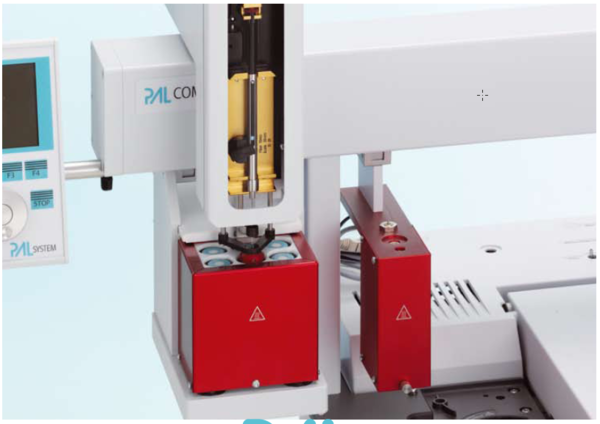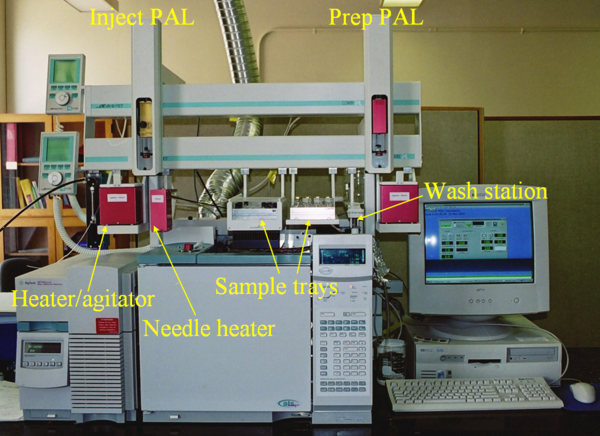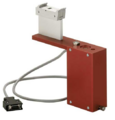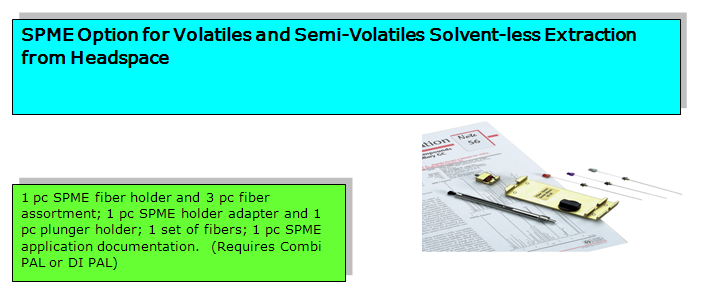SPME
From LEAP
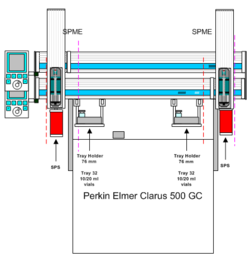
| GC SPME |
| Application Type | |
| STANDARD | |
| Application ID | |
| GCSPME | |
| Description | |
| GC SPME |
Contents |
Abstract
Solid phase microextraction, or SPME, is a sample preparation technique used both in the laboratory and on-site. Developed in the early 1990s at the University of Waterloo by Dr. Pawliszyn's group, it is a simple and inexpensive technique where the use of solvents is not necessary.
SPME can be thought of as a very short gas chromatography column turned inside out. SPME involves the use of a fiber coated with an extracting phase, that can be a liquid (polymer) or a solid (sorbent), which extracts different kinds of analytes (including both volatile and non-volatile) from different kinds of media, that can be in liquid or gas phase. The quantity of analyte extracted by the fiber is proportional to its concentration in the sample so long as equilibrium is reached or, in case of short time pre-equilibrium, with help of convection or agitation. After extraction, the SPME fiber is transferred to the injection port of separating instruments, such as a Gas Chromatograph, where desorption of the analyte takes place and analysis is carried out.
The attraction of SPME is that the extraction is fast and simple and can be done without solvents, and detection limits can reach parts per trillion (ppt) levels for certain compounds. SPME also has great potential for field applications; on-site sampling can be done even by nonscientists without the need to have a GC-MS at each location. When properly stored, samples can be analyzed days later in the laboratory without significant loss of volatiles.
Solid phase microextraction is a fast, solvent less alternative to conventional sample extraction techniques. In SPME, analytes establish equilibria among the sample matrix, the headspace above the sample, and a polymer-coated fused fiber, then are desorbed from the fiber to a chromatography column. Because analytes are concentrated on the fiber, and are rapidly delivered to the column, minimum detection limits are improved and resolution is maintained. SPME is compatible with analyte separation/detection by gas chromatography or HPLC, and provides linear results for wide concentrations of analytes.
SPME is an equilibrium process based upon Fick’s 1st law of diffusion
SPME is a technique where the sample is incubated or agitated to equilibrate the headspace. A SPME fiber is then introduced to the headspace for a predetermined period of time. The SPME fiber is then transferred to a hot GC injection port. Analytes that were adsorbed to the fiber from the sample headspace are desorbed directly in the GC inlet. SPME fibers are a distributed by Supleco and are available in a wide variety of polarities. By matching fiber polarity with target analyte characteristics, the analysis can be optimized for improved sensitivity and performance.
SPME extraction for heated and agitated samples
For use with standard SUPELCO SPME fibers
Septumless Injector and SPME liners recommended
Photos
SPME offers some important advantages:
- Single Step Extraction - reduces sample preparation time by 70%
- Versatility - various selectivities available, adapts to any GC or HPLC system, can be automated
- Efficient & Economical - little/no use of solvents, quantitative method, allows more than 50 extractions per fiber on average
- Single Magnet Mixer (SMM) is a heated stirring device. The stirring is performed by a magnet, which is placed inside the vial. This object is especially useful if you intend to do more liquid SPME than headspace SPME. The LEAP SMM is gentle to the fiber while it is immersed in the liquid. There is a higher efficiency with stirring as opposed to shaking, generating higher responses for semi-volatiles
Comparison of SPME to SPE
SPE exhaustively extracts all of the analytes, but they are diluted during elution 1mL of sample containing 1µg/mL of analyte passed through tube, eluted with 1mL of solvent = 1µg/mL X 1µl injection = 1ng (Concentrating to 100µl or injecting 10µl = 10ng on column
SPME partially extracts analytes but desorbs the entire amount 1mL sample containing 1µg/mL of analyte extracted with fiber. 1% goes on fiber. 0.01 x 1µg = 10ng desorbed on column
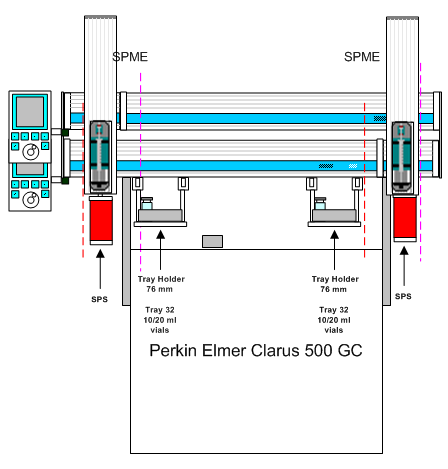
Dual SPME is now possible
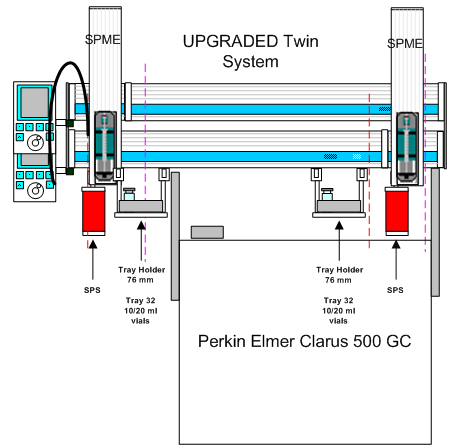
LEAP now has the ability increase SPME throughput with Chronos Scheduling software
This is performed with a Dual Rail SPME extraction and injection to a GC. Synchronization with the GC can be integrated with Chronos or with contact closure. To achieve optimal throughput, the second arm will be prepping with SPME on separate tray and Single Position Stirrer while the previous GC run is in progress. This allows "Prep Ahead" functionality never before capable. Shown with 2 LEAP Single Magnet Mixers (SMM) being used as a heated stirring device. The stirring is performed by a magnet, which is placed inside the vial. This object is especially useful if you intend to do more liquid SPME than headspace SPME. The LEAP SMM is gentle to the fiber while it is immersed in the liquid. There is a higher efficiency with stirring as opposed to shaking, generating higher responses for semi-volatiles
Downloads
![]() GC TWIN PAL Flyer for SPE and SPME
GC TWIN PAL Flyer for SPE and SPME
Useful links
![]() Supelco /Sigma Aldrich SPME Website and information
Supelco /Sigma Aldrich SPME Website and information
![]() Solid Phase Micro Extraction Quantification and Troubleshooting
Solid Phase Micro Extraction Quantification and Troubleshooting
![]() General Information on Gas Chromatography from Wikipedia
General Information on Gas Chromatography from Wikipedia
![]() Definition of SPME from Wikipedia
Definition of SPME from Wikipedia
Video
![]() SPME on the PAL Uses Windows Media Player to view
SPME on the PAL Uses Windows Media Player to view
![]() Video File Movie of the COMBI PAL with SPME in action
Video File Movie of the COMBI PAL with SPME in action
![]() LEAP's PAL Application Videos on YouTube
LEAP's PAL Application Videos on YouTube
Accessories
LEAP Technologies strives to find total solutions for analytical lab automation by automating analytical processes for small and large molecules in extracted liquids, solids, and recently in human, animal and plant tissues. We provide the precise robotics and efficient sample prep required by modern measurement techniques such as MALDITOF mass spectroscopy. Our newest specialty customization of CTC Analytics’ PAL features small workstations that can perform complex liquid handling tasks including HPLC-Purification, SPE, filtration, weighing, heating and stirring. They can be configured as stand alone units or integrated for “just in time” sample prep for LC-MS or GC-MS analysis.
LEAP provides automated workstation instrumentation solutions based on the LEAP CTC PAL X, Y, Z syringe only autosampler robot from LEAP Technologies. This extremely flexible, precise, and adaptable liquid handling robotic platform is available in a variety of lengths and options depending on the requirements of your sample preparation and injections for your UHPLC, LC or GC chromatography.LEAP offers full support and service for the PAL platform in addition to being able to write custom macros, cycles, and scheduling to your applications. Please contact LEAP Technologies on how we can help you get maximized throughput with flexible pipetting automation solutions.
Contact LEAP
For additional information about LEAP and the PAL Platform, please contact LEAP Technologies. |

